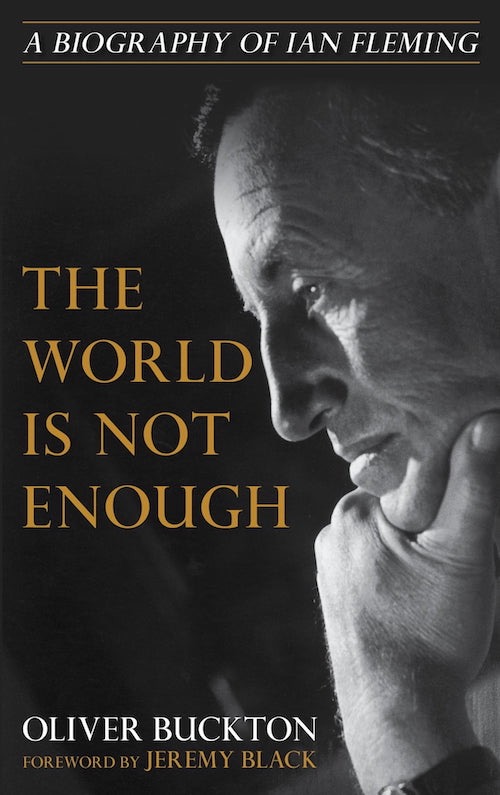Raiding the Disney Vault
In his recent book The World Is Not Enough, Oliver Buckton draws connections between Ian Fleming’s life and his literary output, suggesting that the author’s family ties, education and wartime experience all left indelible traces in the Bond novels.

According to Buckton, if Bond villains seem to address their helpless captives with the language a stern headmaster might employ when dressing down a disappointing young scholar, we can thank Mr. Fleming’s checkered academic career. The location of Blofeld’s sinister Alpine clinic, the scene of a wartime murder addressed in the short story “Octopussy" and the tragic ending of OHMSS, all seem to stem from Fleming’s memories of his rigorous studies in Kitzbühel.
Buckton also posits that the death of Fleming’s beloved Muriel Wright as she slept during a German air raid was the inspiration for Bond’s line “She’s having a rest” at the end of OHMSS. Is it really a reference to the death of Muriel, or a signal that Fleming will follow up his adaptation of Sir Gawain and the Green Knight with the saga of Sir Orfeo?
It could be both, a fine example of Fleming’s ability to keep numerous plates spinning at the same time. Bond is Orfeo in the Otherworld in YOLT, just as much as he’s Bond in mourning, or Hercules in the Underworld, or even Hercules tamed by the Queen of Lydia.
Is Tracy killed by Blofeld in OHMSS or is she whisked away by the Fairy King? Does it have to be one or the other? She’s certainly dead at the end of one novel. But in the sequel Bond will enter the realm of the dead and come away with another version of her, because, as Buckton tells us, Bond girls are more or less interchangeable. They’re all Muriel Wright to some degree.
Even when Fleming adapts a fairy tale, he can’t stick to just one. Auric Goldfinger may be Rumpelstiltskin, but he also carries a hint of the Pied Piper and the Emperor clothed with invisible finery. Is that hood’s congress in Goldfinger a lampoon of a high-pressure sales seminar or a version of the Mad Hatter’s Tea Party? In Fleming’s world it can be more than one thing at a time.
A few months ago I decided to watch Sleeping Beauty for the first time in forty years, mostly to refresh my memory about the many changes the Disney team imposed on Charles Perrault’s twisted version of an age-old tale. After all there is an evil queen in Perrault’s story who suddenly develops an obsession with eating the awakened princess’s children one-by-one as appetizers for the main course, which is to be the princess herself. That’s a line even Rosa Kleb might hesitate to cross.
As I watched I kept wondering, When do those amusing mice show up? - being quite certain that I remembered seeing some mice dressed in simple peasant clothes, who are continually menaced by a diabolical cat.
Of course I was remembering Disney’s Cinderella, which introduced mice as a substratum in the household of Cinderella’s wicked stepmother. It was the creative team’s way of padding out a spindly story while also generating some real tension. After all, we know things will turn out well for Cinderella, but those mice could easily fall prey to the cunning Lucifer, and we’re genuinely worried for them.
I wonder if Fleming had Disney’s rodential subplot for Cinderella in mind when he dreamed up the gypsy camp in From Russia With Love. Kerim Bey’s faithful allies can be seen as a microcosm of the chess game being played out on a larger stage, besides providing an exotic side-trip before we climb aboard the Orient Express for a long, thundering ride across the landscape of postwar Europe.
Following this line of thinking also leads me to wonder whether From Russia With Love’s villainous Krilencu is, to some degree, modeled after Cinderella’s Lucifer, who, come to think of it, also ends up falling from a high tower never to be seen again. As for the trusty hound Bruno - more about him later.*
While Fleming clearly aimed to make From Russia, With Love a cockeyed version of Sleeping Beauty, a fairy tale which was just then being adapted for the screen by the Walt Disney Studio, it seems likely that he scooped up other spare parts from the Disney vault. After appropriating Snow White’s magic mirror for the bridal suite of the Kristal Palas, perhaps he realized that he could also make use of a few of Cinderella’s miniature companions, along with their evil nemesis, to spice up his story.
From Russia, With Love is at heart a fairy tale, but sometimes one fairy tale just isn’t enough.
* See “Dogs and Cats Living Together” and “If the Slipper Fits"